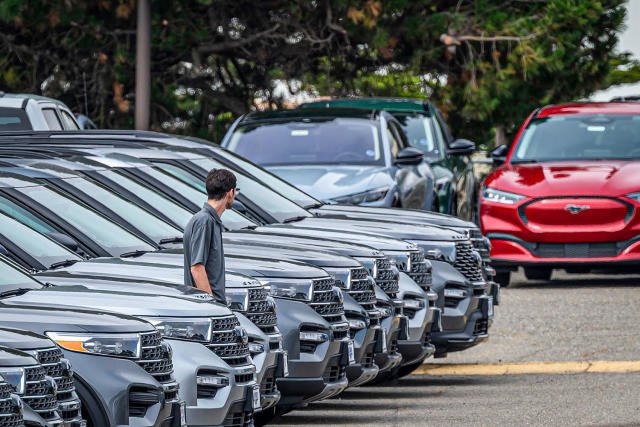Introduction: A Bright Outlook for the U.S. Auto Industry in 2025
The U.S. auto industry is projected to experience a significant rebound in 2025, with sales expected to reach their highest level since 2019. After navigating a series of challenges, including the global pandemic, semiconductor shortages, and economic uncertainties, car sales are forecasted to surge. This recovery reflects a combination of factors such as a strong economy, improved vehicle supply, and consumer demand for new cars and trucks. In this article, we will explore the factors driving this optimistic forecast, what it means for consumers and manufacturers, and the overall impact on the U.S. economy.
Factors Driving the Strong Outlook for 2025 U.S. Auto Sales
The U.S. auto industry has been through a tumultuous period in recent years, but the future looks brighter for 2025. Several key factors are contributing to the anticipated surge in sales.
1. Economic Recovery and Consumer Confidence
Following the economic downturn caused by the COVID-19 pandemic, the U.S. economy has shown remarkable resilience. Consumer confidence is on the rise, driven by a steady recovery in employment rates, increased wages, and a resurgence in consumer spending. As people feel more financially secure, they are more inclined to make large purchases, including new vehicles.
Increased disposable income and a strong job market are key indicators of economic stability, encouraging Americans to invest in long-term assets such as cars, particularly given the growing importance of vehicles in everyday life.
2. Supply Chain Improvements
For the past few years, the auto industry has struggled with supply chain disruptions, particularly the shortage of semiconductor chips that are vital for vehicle production. However, these supply chain issues are gradually improving as manufacturers and suppliers adapt to new processes and technologies. In 2025, vehicle production is expected to ramp up significantly, which will make more cars available for purchase and, in turn, increase sales numbers.
Manufacturers are also focusing on localizing supply chains, reducing dependence on overseas suppliers, and investing in more resilient manufacturing systems. These changes should help mitigate the supply shortages that have plagued the industry for years.
3. The Shift to Electric Vehicles (EVs)
One of the most significant trends shaping the future of the auto industry is the widespread adoption of electric vehicles (EVs). Consumers are increasingly attracted to EVs due to their environmental benefits, lower operating costs, and advancements in technology.
Government incentives, such as tax credits for EV buyers, are further stimulating demand for electric cars. Additionally, automakers are introducing a wider range of EV models, which offers more choices to potential buyers. The U.S. government’s push toward clean energy and emissions reductions has also led to investments in EV infrastructure, including more charging stations across the country. This growing EV infrastructure is addressing one of the biggest challenges to EV adoption, making electric cars a more practical option for a larger segment of the population.
4. Increased Inventory and Better Availability of Vehicles
During the last few years, inventory levels at dealerships were significantly reduced due to the aforementioned production shortages. However, by 2025, manufacturers are expected to have caught up with production targets. This means dealerships will be able to offer a wider variety of new cars, trucks, and SUVs. Consumers will have more options to choose from, including models with improved features and new technologies.
Increased availability is expected to drive sales, as consumers will no longer be forced to wait months to receive their vehicle orders. This influx of new vehicles into the market will ease the pressure on car prices, which have been inflated due to limited supply.
5. Rising Demand for Trucks and SUVs
The popularity of trucks and SUVs in the U.S. market shows no signs of slowing down. These vehicles, which offer ample space, enhanced performance, and versatility, continue to dominate sales. With American consumers prioritizing practicality, especially in suburban and rural areas, the demand for larger vehicles remains strong.
While passenger car sales have been declining in favor of SUVs, these vehicles have consistently outperformed expectations in the U.S. market, making up a significant portion of overall sales. As automakers respond to this shift by introducing more truck and SUV models, including electric variants, sales of these vehicles are expected to remain robust in 2025.
How 2025 Auto Sales Could Impact Consumers
For U.S. consumers, the anticipated rise in auto sales presents several benefits, ranging from more vehicle options to better deals and enhanced technology.
1. More Choices and Better Technology
With the influx of new models on the market, consumers will have a broader range of options to choose from. Automakers are constantly innovating to meet the needs of modern drivers, introducing advanced technologies such as autonomous driving features, enhanced infotainment systems, and improved safety features. The 2025 model year is expected to be rich in technological advancements, which will attract buyers seeking cutting-edge features.
Additionally, as the supply of vehicles increases, consumers will have more bargaining power. With a larger inventory to choose from, dealerships may offer promotions or discounts to attract buyers, further benefiting the consumer.
2. Reduced Waiting Times and Better Availability
One of the most frustrating aspects of the past few years for car buyers has been the long waiting times for vehicle deliveries. With supply chain issues easing, buyers can expect quicker turnaround times for their vehicle purchases. This improvement in availability will lead to a smoother buying experience for consumers, reducing the stress associated with delayed deliveries.
3. Competitive Pricing and Deals
As automakers ramp up production and dealerships have more inventory to sell, competitive pricing will likely be a key factor in attracting buyers. With more vehicles available, dealerships will need to offer competitive deals, including financing options, discounts, and other incentives to entice buyers. This could result in more affordable prices for both traditional gasoline-powered vehicles and electric models.
4. Incentives and Rebates
In addition to competitive pricing, consumers can expect to see continued incentives for purchasing new cars. Tax rebates and incentives for electric vehicles will remain a major draw for eco-conscious buyers. As the government continues to push for greener alternatives, these incentives will make EVs more accessible to the average consumer.
Challenges That Could Still Hinder Sales Growth
While the outlook for 2025 is overwhelmingly positive, several factors could still impede the growth of U.S. auto sales.
1. Economic Uncertainty
Despite the recovery in the job market, economic uncertainty could still affect consumer spending. Rising interest rates, inflation, and potential economic downturns could lead to a decline in demand for high-cost items like vehicles. If the broader economy experiences a slowdown, it could dampen the growth in auto sales.
2. Rising Interest Rates
As interest rates continue to rise in response to inflationary pressures, auto loan rates are also likely to increase. Higher interest rates could discourage some potential buyers from taking out car loans, reducing their purchasing power. This could result in fewer buyers opting for new vehicles, which could lower the overall sales numbers.
3. Global Supply Chain Instability
While supply chains are recovering, the potential for disruptions still exists. Factors such as geopolitical tensions, natural disasters, and trade policy changes could once again create delays in vehicle production and delivery. This could once again limit vehicle availability and raise prices, dampening the growth forecast for the industry.
Conclusion: A Promising Future for the U.S. Auto Industry
Overall, 2025 is shaping up to be a year of recovery and growth for the U.S. auto industry. With improvements in supply chains, a stronger economy, and increased consumer confidence, auto sales are expected to reach their highest levels since 2019.
For consumers, this means more choices, better prices, and access to cutting-edge technology. However, challenges such as economic uncertainty, rising interest rates, and potential supply chain disruptions remain. Despite these risks, the outlook for the industry remains strong, and 2025 is poised to be a year of revitalization for the U.S. automotive market.





Leave a Comment